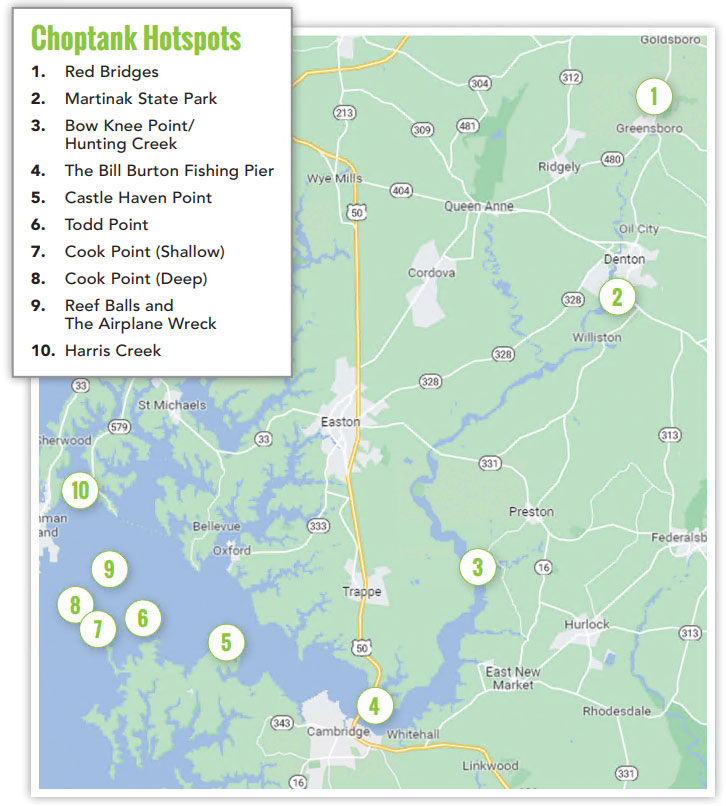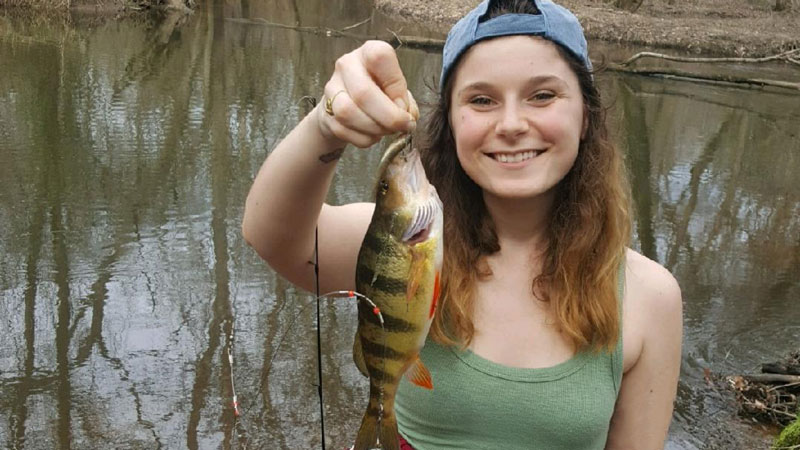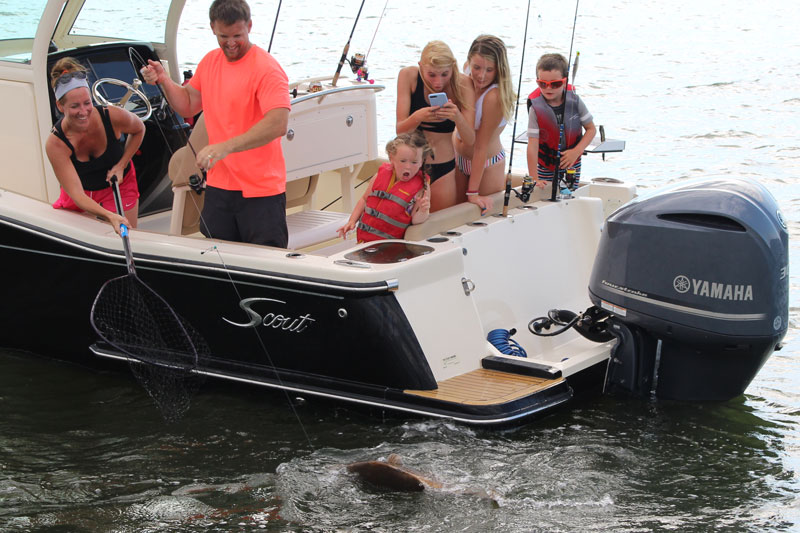The Choptank River is uniquely situated far enough south to enjoy southern species like speckled trout and Spanish mackerel for much of the season, yet far enough north to enjoy a solid striped bass bite virtually year-round. Its erratic shoreline holds promise at virtually every point, and unique structure ranging from islands to airplanes provides habitat prime for everything from trolling to casting light tackle in the shallows. Far from any major metropolitan areas, Cambridge and Denton are the only significant population densities bordering the river and by modern standards its waters are much healthier than most Bay tributaries. In short, the Choptank is a Chesapeake treasure — especially if you know where and how to fish it.

If one sat down and counted, the hotspots in this river would surely expand into the hundreds. We’ll focus on just 10, and although these spots are all fairly well-known in the angling community, each holds a unique characteristic that makes it well worth visiting.
Red Bridges
Parents have been taking their kids to enjoy the red-hot spring perch action at Red Bridges for generations. Pull down Red Bridges Road just north of Greensboro, park in the gravel lot at the end of the road, and fish right there or walk down the path along the river’s edge. While most folks come here in March or April to catch perch hand over fist, this stretch of the Choptank is actually well worth visiting any time of the year. Crappie, bass, pickerel, and fallfish are among the species you might catch here during every season; try tossing shad darts tipped with grass shrimp or minnow, or suspending a small minnow under a bobber.

Martinak State Park
About nine miles downriver from Red Bridges the Choptank opens up significantly at Martinak State Park, where Watts Creek shoots off from the main stem. At any time of year anglers can launch a boat and fish for freshwater species in the river itself, or cast from the shores of the park into the creek. Put a bait on bottom and catch catfish for as close to a sure thing as exists when it comes to fishing. Better yet, pay this spot a visit in the dead of winter. There’s a covered pavilion built out over the water next to a deep hole, where yellow perch stage in massive numbers prior to the spring run and will quickly chomp on bull minnow fished on a bottom rig. With a roof overhead and a railed platform to cast from, this is among the best spots around to take young children fishing when it’s rainy or even snowing outside. (Note: this park has several improvements under construction as we go to press including at the boat ramp and pier; completion was expected by spring of 2023 but check the website for updates before visiting in the near future).
Bow Knee Point/Hunting Creek
More than halfway from Denton to Cambridge the river takes a sharp bend at Bow Knee Point, directly across from Hunting Creek. A public marina and boat ramp at Choptank Marina (Caroline County trailer permit required) offer water access to this stretch of the water, where eons of current have scoured out a deep hole that goes beyond 50 feet in some areas. This is prime catfish territory (cut bait of any sort on bottom generally does the trick) and in the summer months salty species will also visit this stretch of the river many seasons. Or take a turn up into Hunting Creek, and probe the shallows and coves in search of the prolific snakeheads.
The Bill Burton Fishing Pier
Long a favorite of boatless anglers, the Bill Burton Fishing Pier in Cambridge is currently closed pending a study of structural stability. However, boat anglers can still reach the old Route 50 bridge’s pilings, and other areas of the Bill Burton Fishing Pier State Park remain open. This includes the trail on the north shore of the river, which provides access to about a third of a mile of shoreline. While the bulk of the catch in this section of the river mostly consists of perch, catfish, and rockfish, it is far enough downstream that all bets are off. Some years croaker swim these waters in good numbers, bluefish could show up during the summer months, and even species like flounder and speckled trout can appear from time to time. For quick bites toss out a bottom rig baited with bloodworms, and keep a live-lining rig handy so any spot you may catch can get tossed right back out for rockfish.
Castle Haven Point
Run seven miles downriver from the Bill Burton Pier and you’ll see Castle Haven Point to your south. What you might not see, however, is the underwater feature here that draws in fish. The point extends out from shore, and between the red number 16 marker and the red number 2 buoy, a sheer ledge drops from four or five feet down into the 20s on the east side, and to over 80 feet of water on the north side. This edge gets plenty of current, and as one might expect, it’s an excellent area to fish. Rockfish often congregate along the edge in 10 to 25 feet of water and when weakfish were around, this used to be a great spot to locate them. Some seasons flounder will also congregate along the edge, mostly in the 12- to 30-foot range, where jigging Gulp! on a three-quarter or one-ounce head can be very productive.
Todd Point
Just off Todd Point, on the southern shore of the river close to its mouth, there’s a series of rock structures left behind by shoreline erosion which today sit in several feet of water. Those rocks attract stripers virtually every season, and in years when speckled trout move up the Bay, this area is often a reliable hotspot. Though they are charted and will appear on any chartplotter with a decent database their exact position doesn’t match up well and the tricky part about fishing here is finding the rocks without finding them the hard way — and doing serious damage to your prop. The upriver structure is the rectangular foundation of what appears to be an old house, then there’s a substantial gap, then a line of riprap running parallel to the shoreline. On a high tide these are all hidden from view (until it’s too late) and on a low tide most of the riprap is barely visible but the foundation isn’t until you’re right on top of it. If you’re not familiar with this spot the best way to locate it is to come armed with side-scan and an electric trolling motor, and creep along gingerly. Once the rocks are located, pitch quarter-ounce jigheads with soft plastics and hold on tight.
Cook Point (Shallow)
Cook Point is another area that can be a bit dangerous to visit if you aren’t careful, but the fishing here is more than worth the risk as long as you move your boat slowly and cautiously. Rather than rocks, trees are the main fish-attracting impediment. The tip of the point was cut off from land and now forms a small island, which often has rockfish and sometimes speckled trout along its banks. Between the island and the trees lying in the water on the mainland side there’s a channel of several feet which is navigable by most outboard boats (though anything bigger than 26’ is pushing its luck here) but there are several trees and/or stumps in here as well, so again, caution is necessary. Also expect to lose plenty of jigs and plugs as you cast to the standing timber. In-between snags, however, you’re very likely to hook up.
Cook Point (Deep)
Travel about three quarters of the way from the Cook Point island to the red number 10 marker, and you’ll find a drop-off from five to 50 feet. This is a slow slope so it may take a while to drift down, and you may find the fish in one depth range or another. Most of the time, however, you will find fish here. Flounder love this edge (though the vast majority have been throwbacks in recent years), bottom fish including spot and croaker meander back and forth across it, and in years past when weakfish came up the Bay they’d be found here, too. Try drifting a Fluke Killer rig baited with peeler crab or bouncing a Gulp! along bottom for the larger species, or use a bottom rig and bloodworms to tempt the panfish found here.

Reef Balls and The Airplane Wreck
Slightly northeast of the red 10 lies the famed Choptank Airplane Wreck and an oyster replenishment reef lined with reef balls. Both are clearly and accurately charted and finding them with your GPS and a fishfinder won’t prove too challenging. The Airplane Wreck has deteriorated over the years while the reef balls have been proven fish-attractors. Drifting them can be tough as it leads to lots of snags, and most anglers will either anchor up or Spot-Lock here. Through much of the season rockfish will be found close by, and bottom fish including spot and croaker (and toadfish — lots and lots of toadfish) are also in attendance. The uber-cool possibility here, however, is of hooking into a big black drum. From late June into the summer months they sometimes set up shop in the area, providing as big a tug as any likely to be felt on the Chesapeake Bay. Drop down large chunks of peeler or soft crab and let them sit to get those big boys biting.
Harris Creek
Travel to the northern mouth of the river and past Tilghman Island, and you’ll soon enter Harris Creek. This is the location of one of the Bay’s largest oyster restoration projects, with over two billion spat planted in the creek’s waters. And apparently it’s had an impact, because this is one of the few Chesapeake waterways where you can actually sight-cast to striped bass. You can see bottom in several feet of water (as long as the wind hasn’t churned things up) and there are plenty of grass beds. Creep along their edges and look carefully at the potholes in the weeds, and be ready to cast a jig, swimbait, or floating crankbait the moment you see the long, dark back of a striped bass cruising for a meal.
From its freshwater headwaters to its junction with the Chesapeake Bay, the Choptank River offers some of the finest fishing any tributary can boast. So be sure to visit one of these hotspots — or all of them — and you’re sure to discover some of the hundreds of other hotspots in-between.
Sign up here to get the weekly FishTalk Chesapeake Bay and Mid-Atlantic fishing reports in your email inbox, every Friday by noon.